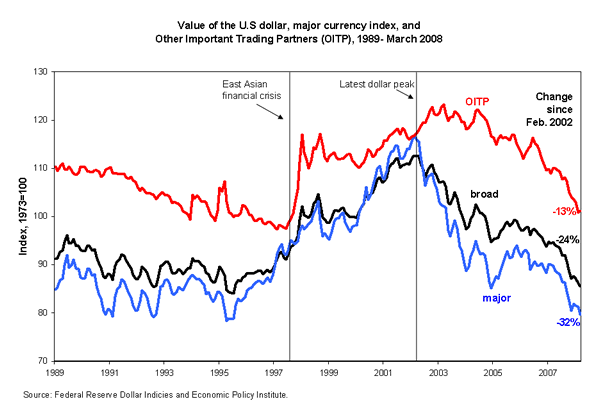See Snapshots archive.
Snapshot for March 26, 2008.
Moving toward a sustainable dollar
by Robert Scott with research assistance by Lauren Marra
The dollar’s decline against other currencies is often misunderstood to be a crisis—an understandable mistake, since news reports often describe the result of this process as a “weaker” dollar. In fact, what is happening is a necessary process that restores balance between the dollar’s value, which became superheated in recent years, and that of other currencies. This readjustment can carry great benefits for the U.S. economy by helping to reduce unsustainable U.S. trade (i.e., current account) deficits and create a level playing field where U.S-made goods can better compete for market share at home and abroad.
The Federal Reserve tracks three primary indices of the dollar’s real, inflation-adjusted value: the broad dollar index, the major currency index, and the other important trading partner (OITP) index. The broad dollar index includes currencies that are freely tradable and are set by markets with little government intervention. This index shows that the dollar has depreciated about 24% since February 2002, when this index last peaked (see chart). Most of this decline is explained by a sharp fall in the dollar against the currencies of our major trading partners, which averaged 32%, as shown in the chart.1
While the major and broad dollar indices have fallen sharply in this period, the current account—which is the broadest measure of U.S. goods, services and income trade—has improved by less than 2 percentage points, as a share of GDP. (See today’s Current Account Picture).
Further improvement in U.S. trade deficits are being short-circuited because the dollar shows a much smaller decline against currencies in the OITP index. This index comprises 19 nations that are generally quite a bit poorer than the United States, and many of the included currencies (especially the Chinese yuan, which has by far the biggest weight in OITP) are actively managed by governments to keep their exports competitive in the U.S. market.2 This management is why the dollar has declined so much less against the OITP index than the major currency index—only 13% over the past five years. In addition, the dollar has also fallen only 12% against the Japanese yen since its peak, and most of this decline occurred in 2008.
The countries whose currencies are in the OITP index account for roughly 59% of the current U.S. trade deficit, while countries in the major currency index account for just over 30% (Japan, alone, is responsible for over 10%). Hence, the OITP’s relative stubbornness is problematic for United States and global adjustment and makes strengthening currencies in the OITP index and the Japanese yen even more important for correcting the U.S. trade deficit.
Note: This Snapshot updates a previous Snapshot by L. Josh Bivens, A Plunging Dollar? How Far and Relative to What?
Endnotes
1. The major currency index includes: the euro, the UK pound, the Japanese yen, the Canadian and Australian dollars, the Swiss franc, and the Swedish krona.
2. The OITP index includes the currencies of China, Mexico, Saudi Arabia, Malaysia, Thailand, Korea, Russia, Taiwan, Indonesia, Israel, India, Philippines, Brazil, Colombia, Chile, Argentina, Singapore, and Hong Kong.

